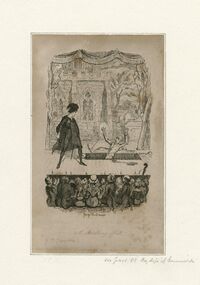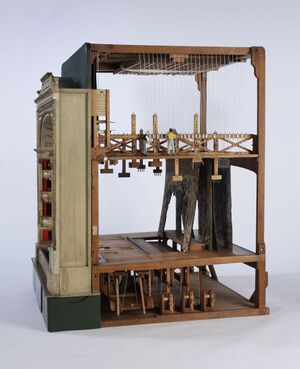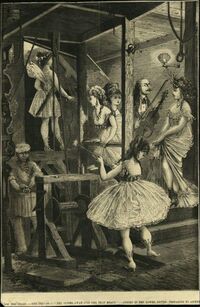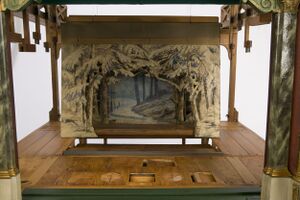Difference between revisions of "A World Below"
| (One intermediate revision by one other user not shown) | |||
| Line 3: | Line 3: | ||
''As well as its practical functions, in Renaissance theatre the space beneath the stage – accessed by traps and lifts – could represent Hell, the world of the dead, and the supernatural, as part of a cosmological conception of the theatre space.'' | ''As well as its practical functions, in Renaissance theatre the space beneath the stage – accessed by traps and lifts – could represent Hell, the world of the dead, and the supernatural, as part of a cosmological conception of the theatre space.'' | ||
| − | [[File:Hodge's conjectural Globe reconstruction.jpg| | + | [[File:Hodge's conjectural Globe reconstruction.jpg|600px|thumb|center|Globe Theatre]] |
Theatrical machinery has been in use since at least the 5th century BCE. In the Colosseum in Rome, animals and objects were raised by elevators onto the stage, as well as gladiators. The medieval mystery plays used stage machinery, including a trapdoor, for the emergence of devils. In the conventions that have lasted from Middle Ages, the mechanised lower stage represented the hell, from which the hellish forms could emerge to spread fear and terror. The stage itself was the earth, and above the heavens (A.02). | Theatrical machinery has been in use since at least the 5th century BCE. In the Colosseum in Rome, animals and objects were raised by elevators onto the stage, as well as gladiators. The medieval mystery plays used stage machinery, including a trapdoor, for the emergence of devils. In the conventions that have lasted from Middle Ages, the mechanised lower stage represented the hell, from which the hellish forms could emerge to spread fear and terror. The stage itself was the earth, and above the heavens (A.02). | ||
| Line 9: | Line 9: | ||
[[File:Sogenannte Hamletversenkung.jpg|300px|thumb|left|“Hamlet-Trap” ]] | [[File:Sogenannte Hamletversenkung.jpg|300px|thumb|left|“Hamlet-Trap” ]] | ||
| − | [[Item:Q7846|The Globe]] (Q7846) was built in 1599, possibly in time for the opening production of ''Henry V'' and its famous reference to the performance crammed within a ‘wooden O’. At same time the [[Item:Q13175|''corrales'']] were developing in the Spanish Empire (E.03, H.03, Q13175). Both types of theatre buildings had simple sub-stage machinery with trapdoors and lifts: Around the stage and surrounding it on three sides, in the Elizabethan as well as in the Spanish Golden Age Theatres there was an area called the ‘yard’ (Spanish: ''corral''), the name deriving from the old inn-yards. | + | [[Item:Q7846|The Globe]], London (Q7846) was built in 1599, possibly in time for the opening production of ''Henry V'' and its famous reference to the performance crammed within a ‘wooden O’. At same time the [[Item:Q13175|''corrales'']] were developing in the Spanish Empire (E.03, H.03, Q13175). Both types of theatre buildings had simple sub-stage machinery with trapdoors and lifts: Around the stage and surrounding it on three sides, in the Elizabethan as well as in the Spanish Golden Age Theatres there was an area called the ‘yard’ (Spanish: ''corral''), the name deriving from the old inn-yards. In London, for a penny, people (the ‘groundlings’) would stand on the rush-strewn earthen floor to watch the performance. At the Globe, a raised rectangular stage platform, also known as an apron stage, thrust out into the middle of the open-air yard. |
[[File:Drury Lane Star trap VA.jpg|300px|thumb|left|Star trap]] | [[File:Drury Lane Star trap VA.jpg|300px|thumb|left|Star trap]] | ||
Latest revision as of 15:12, 11 February 2023
Lifts, traps and Hell beneath the stage
As well as its practical functions, in Renaissance theatre the space beneath the stage – accessed by traps and lifts – could represent Hell, the world of the dead, and the supernatural, as part of a cosmological conception of the theatre space.
Theatrical machinery has been in use since at least the 5th century BCE. In the Colosseum in Rome, animals and objects were raised by elevators onto the stage, as well as gladiators. The medieval mystery plays used stage machinery, including a trapdoor, for the emergence of devils. In the conventions that have lasted from Middle Ages, the mechanised lower stage represented the hell, from which the hellish forms could emerge to spread fear and terror. The stage itself was the earth, and above the heavens (A.02).
The Globe, London (Q7846) was built in 1599, possibly in time for the opening production of Henry V and its famous reference to the performance crammed within a ‘wooden O’. At same time the corrales were developing in the Spanish Empire (E.03, H.03, Q13175). Both types of theatre buildings had simple sub-stage machinery with trapdoors and lifts: Around the stage and surrounding it on three sides, in the Elizabethan as well as in the Spanish Golden Age Theatres there was an area called the ‘yard’ (Spanish: corral), the name deriving from the old inn-yards. In London, for a penny, people (the ‘groundlings’) would stand on the rush-strewn earthen floor to watch the performance. At the Globe, a raised rectangular stage platform, also known as an apron stage, thrust out into the middle of the open-air yard.
The height of the stage was 1.5 m, so the area beneath the stage was easily big enough to hold actors. Trap doors were built into the stage allowing dramatic entrances from the ‘cellarage’ area during the performances of plays. This area underneath the stage was given the title ‘Hell’. This was taken from the term ‘hell mouth’ which was used to refer to any trapdoor in the floor of a stage. Actors would hide in ‘Hell’ waiting to make their entrance or to create other special effects. In the Globe theatre, the Hell below the stage was mirrored by the Heavens above in a literal sense, as the underside of the floor of the tiring house, which formed a ceiling over the inner stage, was painted with stars and the signs of the zodiac. Thus, the theatre became, in miniature, an entire cosmology, in accordance with the religious and philosophical beliefs of its time.
Unusual special effects could be made from ‘Hell’ including sounds using different musical instruments such as the trumpet, or drums. Actors’ skilled in imitating the baying of hounds and crowing of roosters or the wailing of ghostly sounds would also be waiting in ‘Hell’. Here there were also other technical devices such as a lifting machine, with which, for example, the witches in Macbeth were raised through a trap door onto the stage. But the lift also served for the ‘magical’ appearance of set pieces and could take on the meaning of an opening not to Hell, but in the earthly realm, such as a pool of water or a grave.
The Globe theatre stage is believed to have had two trap doors on the outer stage and one trap door on the inner stage (below the tiring house) called the ‘grave trap’. This trap was named for its most famous use, as an open grave in the graveyard scene from Hamlet. Many theatres built since 1600 have also featured grave traps as a permanent part of the stage machinery; they are typically a large, rectangular opening, with the long axis running across the stage, usually positioned downstage centre.
The association of the space below the stage with Hell, the world of the dead and the supernatural continued in the 19th century. The Vampire Trap (Q30596) was invented for James Planché’s 1820 adaption of Polidori’s The Vampyr. It involved two spring leaves that parted under pressure and immediately reclosed. Placed in the floor or stage wall, it could give the impression a figure was passing through solid matter. The Corsican Trap (Q30026), made for Dion Boucicault’s 1852 adaption of Alexandre Dumas’ The Corsican Brothers, involved an ascending track, on which a wheeled cart could be run, rising up out of the stage through a ‘bristle’ trap – a trapdoor covered with bristles painted to match the scenery. Once on the stage and in view, the track was covered by a sliding arrangement similar to a roll-top desk; thus, nothing was seen except the ghost rising up through the floor and gliding across the stage.
The space under the stage often serves a variety of practical purposes, facilitating the performance in various ways. However, it has a long history of being associated with Hell, the world of the dead, and the supernatural – stage mechanisms such as lifts and traps provide passage between the earthly realm and the worlds below.






